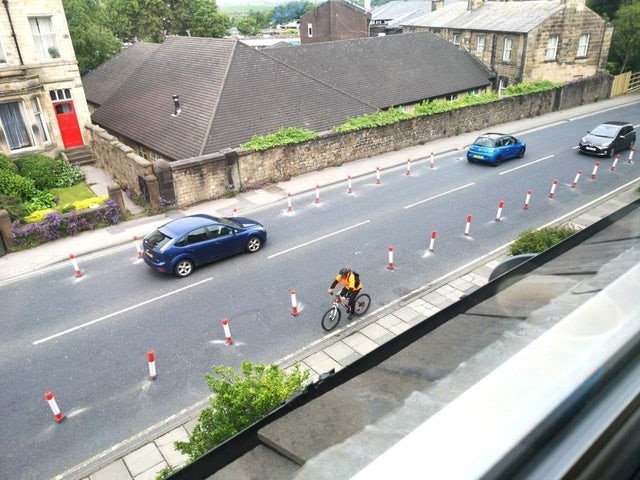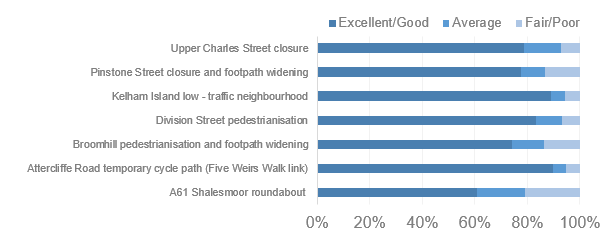by Stephen Parkes
The Covid-19 pandemic and associated national lockdowns brought about rapid changes to how we normally travelled and the frequency of these journeys. In the short-term, the road networks of towns and cities were transformed into quieter and calmer places as much of the population were asked to stay at home to help reduce the spread of the disease. This reduction in personal mobility and a rethinking of travel behaviours, which was instigated by the Government but undertaken by the public, was supported – in part – by a rapid reallocation of road-space.
With travel by public transport discouraged to enable social distancing, there was concern that a rapid increase in car use would create high levels of congestion on the roads, particularly as the most stringent restrictions began to be relaxed. Narrow pavements, particularly around key shopping streets, were also anticipated to undermine efforts to encourage social distancing. In England, local authorities were encouraged and empowered to temporarily provide more space for pedestrians, cyclists, and other ‘active’ travellers, such as those scooting, skating, and running.
Two distinct case-study locations
We undertook research, which was funded by DecarboN8, to examine the use of road-space reallocation measures in two distinct local authorities in England. We were also interested in understanding what impact the pandemic, and these temporary measures, had on people’s travel.
Our case-study locations were Sheffield and Lancashire, which are both in the North of England. Taking a place-based approach allowed us to consider how the impacts played out across two diverse areas. Sheffield is a deindustrialising city with a population of nearly 600,000 (1601 inhabitants per sq. km.). In contrast, Lancashire is a non-metropolitan county with a population of over 1.2 million but dispersed across several smaller towns (including Lancaster and Preston) and a large rural area (424 inhabitants per sq. km.).
The impact of the pandemic on travel behaviour
Through an online survey distributed to residents, we observed how the first national lockdown led to a significant shift in behaviours. Across both case-study areas, whilst the overall number of trips declined, the use of private transport (cars/vans) and active modes (including walking/cycling) increased for those making commuting and shopping trips. The overall changes in behaviour were more pronounced in Sheffield, particularly in relation to increasing use of solely using active modes, or in using active travel as part of combinations of modes. Lancashire had higher levels of car use pre-pandemic and many remained dependent on this during the pandemic.
Across both areas, those not using active modes for certain journeys before the pandemic subsequently tried and sustained, in the short-term at least, shifts to these low carbon modes. This was particularly relevant for those walking for shopping or leisure journeys.
Temporary measures were liked but not always in the right places
Both Sheffield and Lancashire introduced a range of temporary measures to help support more walking, cycling and other active modes, and to minimise pressures on the road network. Proximity to the temporary measures meant that many people did not make use of them, despite awareness of them being high across both case-study areas (70% aware in Lancaster and 88% in Sheffield). Ultimately, Sheffield saw a greater use of the measures (41% of those aware went on to use them) than in Lancashire (21%).


Temporary measures that were introduced ranged from ‘pop-up’ cycle lanes, such as on South Road, Lancaster (left image) and filtered roads to created low-traffic neighbourhoods, such as in Kelham Island, Sheffield (right image).
In Sheffield, those that did use them rated them overwhelmingly positively with measures that removed traffic those that were most highly regarded, as shown in the chart.

Caption: What did Sheffield think about the temporary measures introduced?
Thinking about the longer-term picture
We undertook two further survey waves (March and July 2021) to help give us an idea of the longer-term behaviours of our respondents. The private car was still the most popular mode across the different types of journeys we studied, although it had not returned to pre-pandemic levels. Active travel became more popular for leisure trips, whilst public transport use was still well below pre-pandemic levels although increasing.
The rapid introduction of road-space reallocation measures we studied demonstrates the diverging challenges faced for different areas. The dispersed nature of Lancashire, with several smaller towns, had higher levels of car use pre-pandemic and whilst they introduced more temporary measures than Sheffield, engagement with them was much lower. The more concentrated nature of Sheffield enabled the introduction of measures in places that could yield higher impact.
Whilst places like Sheffield have ambitions to further reallocate road-space away from the private car, the funding and tools must continue to be provided to enable this. An enduring legacy of the pandemic has been the knowledge that we can rapidly put in place trials of new infrastructure at an unprecedented scale and speed, and at low costs in order to rebalance the provision of space. Increasing levels of active travel is an important dimension of the transport decarbonisation challenge and it is vital that Local Authorities continue to be empowered to do this.

